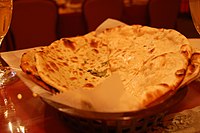Punjabi cuisine
The local cuisine of Punjab is heavily influenced by the agriculture and farming lifestyle prevalent from the times of the ancient Indus Valley civilization.
Dishes similar to tandoori chicken may have existed during the Harappan civilization during the Bronze Age of India.
According to the archeologist Professor Vasant Shinde, the earliest evidence for a dish similar to tandoori chicken can be found in the Harappan civilization and dates back to 3000 BC.
His team has found ancient ovens at Harappan sites which are similar to the tandoors that are used in the state of Punjab.
[1][2][3] Harappan houses had keyhole ovens with central pillars which was used for roasting meats and baking breads.
[5] According to Ahmed (2014), Harappan oven structures may have operated in a similar manner to the modern tandoors of the Punjab.
In the villages many people still employ the traditional methods and equipment for cooking purposes.
[10] In India, tandoori cooking is traditionally associated with Punjab[11] as Punjabis embraced the tandoor on a regional level.
[12] This style of cooking became popular throughout India after the 1947 partition when Punjabis resettled in places such as Delhi.
According to Planalp (1971), "the Panjab-style underground oven known as tandur is becoming increasingly popular in New Delhi" pointing to the Punjabi style of the tandoor.
The state of Punjab has one of the highest capita usage of dairy products in India.
Punjabi cuisine includes various types of desserts and Mithyai which include: Suwaiah-a sweet milk based desert with a special type of pasta[43] Punjabis eat a variety of breads.
Sattu is made by roasting barley grains and then grinding them into powder, mixed with salt and turmeric and water.
Older communities in Punjab also used earth ovens (khadda chulla), but this tradition is dying out now.
[60] According to Ancient Pakistan - An Archaeological History by Mukhtar Ahmed,[61] Harappan oven structures may have operated in a similar manner to the modern tandoors of the Punjab.
The tandoor is traditionally made of clay and is a bell-shaped oven, set into the earth and fired with wood or charcoal reaching high temperatures.
According to Roy Hayter[62] the original versions of the tandoor "in the Punjab, a province in the north-west of India, were sunk neck deep in the ground".
Bringing and sending fresh fruits, sweets and food items as gifts to family members is a common practice in Punjab, particularly during the spring season.
Food items are distributed among neighbors as well on special occasions and as a sign to show hospitality.
It is considered rude if the host starts eating without taking into account the attendance of all guests.
Punjabi families use a hybrid style of South Asian and European utensil etiquette most of the times.
[65] The New Punjab Club,[66] located in Hong Kong, became the world's first Punjabi restaurant to earn one Michelin star in 2019.
















